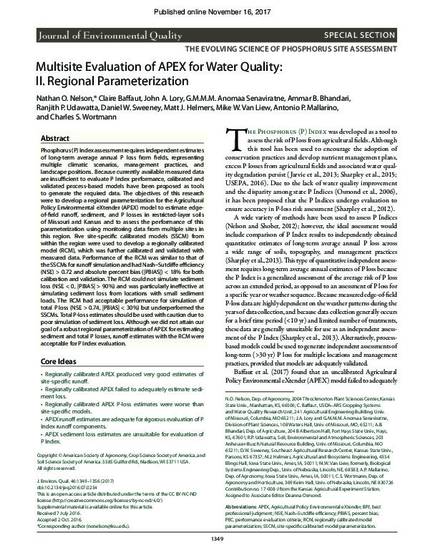
Phosphorus (P) Index assessment requires independent estimates of long-term average annual P loss from fields, representing multiple climatic scenarios, management practices, and landscape positions. Because currently available measured data are insufficient to evaluate P Index performance, calibrated and validated process-based models have been proposed as tools to generate the required data. The objectives of this research were to develop a regional parameterization for the Agricultural Policy Environmental eXtender (APEX) model to estimate edge-of-field runoff, sediment, and P losses in restricted-layer soils of Missouri and Kansas and to assess the performance of this parameterization using monitoring data from multiple sites in this region. Five site-specific calibrated models (SSCM) from within the region were used to develop a regionally calibrated model (RCM), which was further calibrated and validated with measured data. Performance of the RCM was similar to that of the SSCMs for runoff simulation and had Nash–Sutcliffe efficiency (NSE) > 0.72 and absolute percent bias (|PBIAS|) < 18% for both calibration and validation. The RCM could not simulate sediment loss (NSE < 0, |PBIAS| > 90%) and was particularly ineffective at simulating sediment loss from locations with small sediment loads. The RCM had acceptable performance for simulation of total P loss (NSE > 0.74, |PBIAS| < 30%) but underperformed the SSCMs. Total P-loss estimates should be used with caution due to poor simulation of sediment loss. Although we did not attain our goal of a robust regional parameterization of APEX for estimating sediment and total P losses, runoff estimates with the RCM were acceptable for P Index evaluation.
Available at: http://works.bepress.com/matthew_helmers/190/

This article is published as Nelson, Nathan O., Claire Baffaut, John A. Lory, G. M. M. M. Anomaa Senaviratne, Ammar B. Bhandari, Ranjith P. Udawatta, Daniel W. Sweeney et al. "Multisite evaluation of APEX for water quality: II. Regional parameterization." Journal of Environmental Quality 46, no. 6 (2017): 1349-1356. DOI: 10.2134/jeq2016.07.0254. Posted with permission.